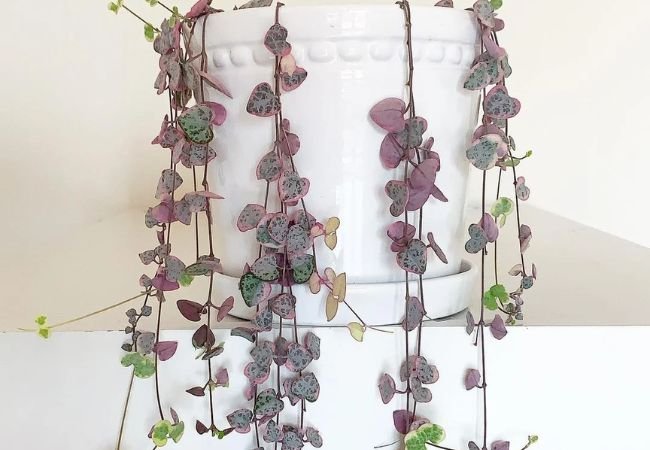Learn how to grow and care for the String of Hearts plant. Discover its unique features, propagation methods and common problems. Perfect for beginners and experienced plant lovers alike.
Hey there, plant lovers! Today we’re talking about the String of Hearts, or Ceropegia woodii if you want to get fancy. This little beauty is taking the indoor plant world by storm, and for good reason. With its heart-shaped leaves and long, stringy vines, it’s basically plant jewelry for your home. Let’s dive into how to keep one of these babies happy and thriving.
Here’s the information about String of Hearts (Ceropegia woodii):
| Aspect | Details |
|---|---|
| Botanical Name | Ceropegia woodii |
| Common Name | String of Hearts, Rosary Vine |
| Plant Type | Succulent, Trailing Vine |
| Hardiness Zone | Zones 10-12 (grown as a houseplant in cooler zones) |
| Sun Exposure | Bright, indirect light |
| Soil Type | Well-draining, sandy or cactus mix soil |
| Watering Needs | Low; water thoroughly when soil is dry, reduce watering in winter |
| Growth Habit | Trailing, cascading |
| Height/Spread | Trails up to 2-4 feet long |
| Special Features | Heart-shaped, variegated leaves, small tubular flowers, easy to propagate, drought-tolerant, ideal for hanging baskets or containers |
What’s the Deal with String of Hearts?

delicate heart-shaped leaves strung along thin, wiry stems that can grow crazy long – we’re talking up to 12 feet! This vine hails from South Africa and it’s technically a succulent, which is great news for those of us who sometimes forget to water our plants (guilty as charged). If you’re curious about succulent diversity, the U.S. Forest Service has some cool info.
Growing Your Own String of Hearts
Light
These guys are sun-lovers, but they’re not fans of getting scorched. Bright, indirect light is their jam. Near a window is perfect, just not right in the sun’s path. The importance of light for houseplants is well explained by Penn State Extension.
Soil and Potting
You’ll want to use soil that drains well. A cactus or succulent mix works great, or you can play mad scientist and mix regular potting soil with some sand and perlite. Oh, and make sure your pot has drainage holes – these plants hate sitting in water.
Watering
String of Hearts is super forgiving if you forget to water. Let the soil dry out completely between waterings. In winter, cut back even more. Seriously, it’s harder to underwater these plants than to overwater them. For more on watering succulents, check out the University of Minnesota Extension’s guide.
Temperature and Humidity
if you’re comfortable, your String of Hearts probably is too. They’re happy in normal room temps, between 60°F and 80°F. And they don’t need high humidity, so no need for any fancy setups.
Fertilizer
During spring and summer, give them a little boost with some all-purpose houseplant fertilizer. Dilute it to half strength and feed them once a month. In fall and winter, let them rest. The importance of fertilizing houseplants is well covered by the University of Maryland Extension.
Making Baby String of Hearts
Want more plants? String of Hearts is super easy to propagate:
- Stem Cuttings: Snip off a piece of stem with a few leaves, stick it in water or soil, and boom – in a few weeks, you’ll have roots.
- Tuber Propagation: Sometimes you’ll see little bead-like growths on the stems. These are tubers, and you can plant them to get new plants. It’s like magic!
Troubleshooting: When Things Go South
Yellow Leaves
Usually means you’re watering too much. Ease up and make sure that soil’s draining well.
Stringy, Sparse Growth: Your plant’s probably not getting enough light. Move it somewhere brighter, but not in direct sun.
Bugs
Keep an eye out for mealybugs or spider mites. If you spot ’em, wipe the leaves with a cotton swab dipped in rubbing alcohol. Take that, bugs! For more on managing houseplant pests, the University of Missouri has some great tips.
Why String of Hearts Rocks
Whether you’re a newbie or a seasoned plant parent, String of Hearts is a great choice. They’re pretty chill about care, don’t need much water, and can handle most home environments. Plus, they look super cool trailing down from a shelf or hanging basket.
Want to nerd out more about the native habitat of String of Hearts? The South African National Biodiversity Institute has some fascinating info on the plant’s natural environment.
Remember, every plant’s a little different, so pay attention to what yours likes. Before you know it, you’ll have a gorgeous String of Hearts thriving in your home. Happy planting, folks!
For more gardening tips and plant care guides, visit usagardenhub.com.


2 thoughts on “String of Hearts : Growing This Unique Trailing Beauty”